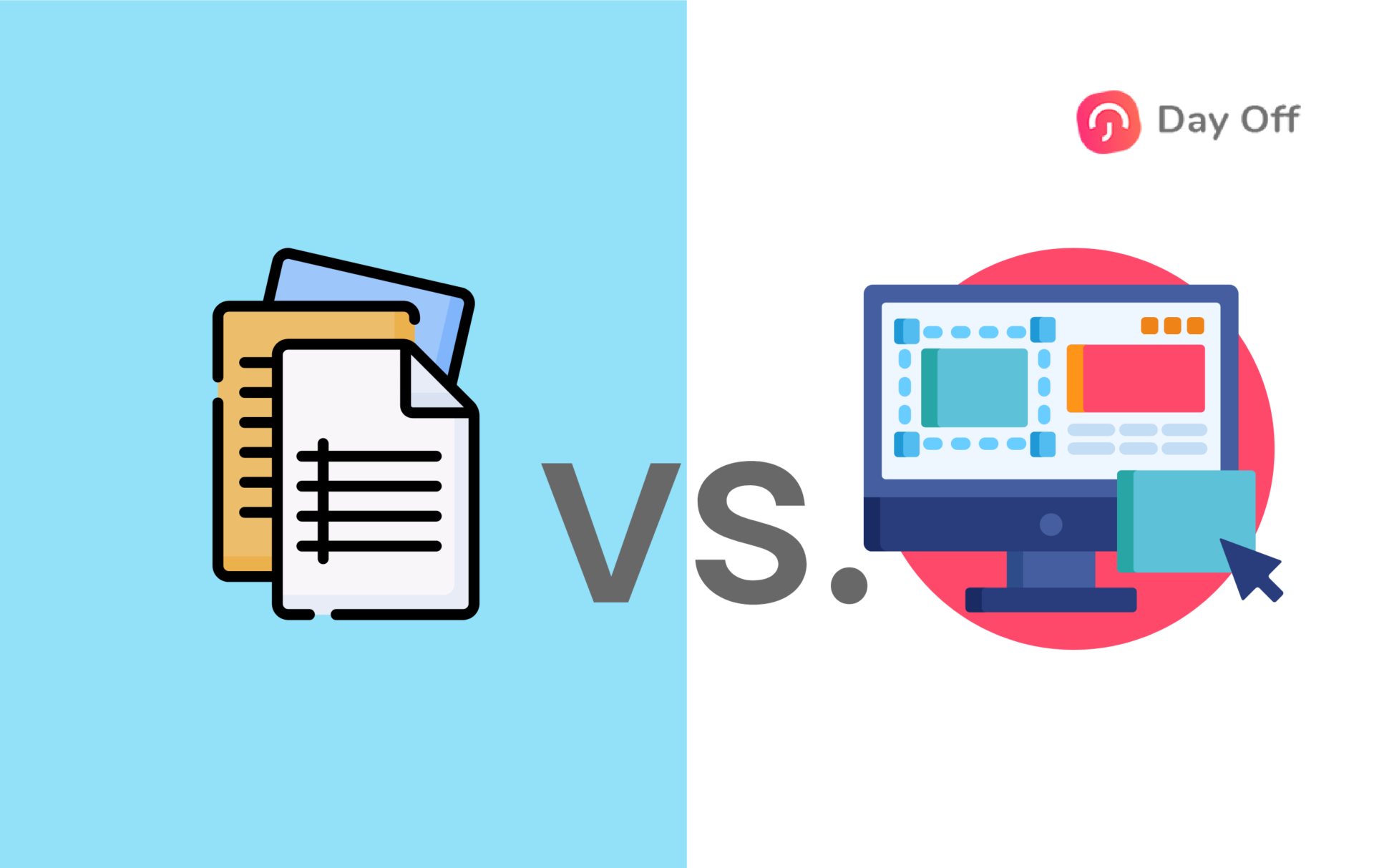The Day Off software or application allows you to tackle the absence, track PTO, vacations, and leaves, as well as enjoy an overview, saving your hours of effort and headache. You can easily scroll through the leave and vacation policies associated with your company using the application. If you are the employer, it can be quite useful as well. Let us take the topic of Leave Management, for instance, to take the Paper vs. Software decision
Paper vs. Leave Management Software is a complicated, yet integral issue for all kinds of companies. Payroll and leave management, Paper vs. Software need to run hand in hand for the company to work efficiently, and it can sometimes be a challenge to do everything on paper. Yet, many companies today find it difficult to use software for this purpose.
We have compiled this guide to talk about the different ways of managing the day off of employees within companies.
Paper vs. Software, pointing out the pros and cons associated with the advancement of technology, which highlights the ability of software to do so.
Why is Leave Management Necessary?
If you own a business or work in the HR department, you must know the importance of leave management: Paper vs. Software. It can be quite challenging to deal with such day-offs, PTOs, or vacations across different departments. Starting with the different types of leaves. Distinguished laws specific to states, and the added tensions of teams regarding the time-offs of some employees, can be quite a headache.
Though it might seem quite straightforward to handle leave management within smaller companies, it can start to become both expensive and complex with the increasing number of employees.
Paper leave management remains a viable option for small businesses, but when the number of employees goes over 20,000, the companies start switching to outsourcing leave management. This might also differ between industries, but it is an issue for most.
Leave Management through Software vs. through Paper
When we are talking about leave management for employees, we are talking about a huge amount of data. There is probably going to be quite a lot of paper documentation crammed in the office cabinets, where you can find tons of employee information that has to stay undamaged and easily accessible. That might be one big reason why HR systems, even today, avoid going paperless.
It is essential to understand that the more you rely on paper, the greater the effort you have to put in to manage it all. One solution can be attempting to scan all the hard copy data into a soft copy format.
This can take some time to kick off, but once done, the integration of the paper-based content can be quite simple with a software HR system, for day-off trackers, PTO trackers, etc.
Some managers argue that paper is no hassle, given the fact that all the printed documents are usually filed in a relevant sequence, more often than not according to the name of the employee. You can, however, maintain this sequence when converting the papers to a digital form to track the information well.
Sometimes you may wonder why software is essential to management or tracking the leave of employees when you have dedicated HR within your company to keep an eye on the issue. We have some benefits here that you might consider.
Time and Energy
At the end of the day, you need your company to run all its operations in a streamlined manner. This means you need to save the time as well as the effort that your employees put into it. When you use the software as your PTO tracker and leave tracker, you can integrate both the payroll systems and the leave-management parts of your company and reduce the double work of data processing.
Since both payroll and leave-management systems deal with the information of the same employee, it makes sense to have them handled through a database or software instead of having an individual go through different paper files to keep the account.
You can simply enter the information once and easily track attendance, leave, pay, and all kinds of records. It can automate a lot of the functions that would take hours through the paper system. Sometimes, employees can also enter their details, hence saving time and effort for your HR.
More Accessible
Usually, the vacation tracker, PTO tracking software, or leave tracker app can be installed on different devices. When the software is available in the form of an application, for instance, an Employee leaver tracker app or an Employee time off tracker, it is easily manageable through different smartphones, tablets, iPads, etc.
Accuracy and Compliance
The computer software or application is likely to make fewer mistakes in terms of calculating payroll based on PTO or leaves than paper leave-management methods. The latter runs the risk of more mistakes occurring due to human error.
When you are required to stick to paper for handling leaves, it increases the bureaucracy. Someone who wants to apply for leave first has to complete a form, hand it to the manager, and wait for him or her to sign and approve. The manager then has to pass it on to payroll for further processing. This tends to be quite inefficient and risky, requiring additional labor.
The paper management can require between 73 and 124 minutes, while the software or application will cost you a maximum of 30 minutes. In the latter case, you simply have to make the minimum number of steps.
Even considering that you make multiple changes, it will take less than 1 minute to update the online form. The system is automated to go into contact with the relevant parties whenever any change arises. The redundant tasks will be avoided.
If there is an error in the leave management, it can badly harm the business. In the worst situations, business owners or HR can even be sued or fined for miscalculations or underpayments for the smallest of mistakes in timekeeping systems.
Limited Manual Interventions
There have been issues faced by several businesses, whereby some people have made unauthorized changes to the leave management system through manual interventions in the paper-based system.
This results in fraud- employees taking a vacation, a day off, or leave and then removing the record, or taking one day less than how it should be, or manually making changes to the number of leave days available to one individual.
When you switch to a software or application, this opportunity to commit fraud is easily minimized.
Transparency
When you use software or an application to input planned vacations or unplanned leaves, all the data can be accumulated by a comprehensive dashboard. This will allow you to have a clear overview of all the metrics related to the day-offs of your employees.
There is no way the approval of the managers can be skipped. Furthermore, you can also track if anyone is abusing the policies associated with leave or underutilizing the vacation hours, and even working below standard.
In short, the application or software, unlike the paper management system, can easily spot the leaks in employee performance or tackle the issues of absenteeism more efficiently. You can also see if your company needs any specific improvement and make changes to the current approach depending on the requirements.
Customizable for every location
If you have employees working in different parts of the globe, a free time off tracker or Day Off App can highly benefit both your employees and your company. The free vacation tracker can help both of you keep an eye on the status. These apps can also be customized (with the required settings) for different locations across the globe.
Furthermore, when you have an overview through the app,
HR can ensure that key employees plan their leaves at the same time. You can also try to make the settings suited to your preferences.
Cost
You can highly contribute to saving on the cost of paper,
time, as well as disputes arising from leave and vacations of your employees. The cost of hiring extra professionals to run the leave balance or HR overheads can be avoided with the software versions. It can also help to remain fair in enforcing the policies related to PTO and leaves.
Reporting
When all the day-offs are planned using the Day Off App or through an employee time off tracker,
you can have all the employee-related data and company-wide information in one place. Most of these applications come with an integrated reporting module that makes it quite simple to analyze patterns,
as well as to get the proper insight into the employees.
Data Loss
Even if your company goes through an accident,
like an unavoidable fire or a simple spilling of drinks on the paper lying around, if you depend on software for leave management, you can avoid the data loss. You can store the information in the cloud and access it anytime from anywhere you allow.
Values
With software or an application working as a leave tracker or time-off app, you can start to build a strong company culture, where you highlight transparency and compliance as the main factors that cultivate trust among the employees, regardless of who they are.
You can start to promote other company values based on these aspects as well. If you do not have these strong values, you will soon end up with people working in your business for nothing more than the remuneration.
Simpler Audits and backward reviews
You can easily keep an eye on what edits and audits have been made to the different leaves or vacations associated with the different employees throughout your company if you are using the software system. This is quite impossible or difficult to do easily when you depend on paper for leave management.
You may need to check the archived information, for instance, when making a deal or agreement with an employee or former employee, the employee rights control agencies, or some external parties, by checking your audits. The software can be regarded as a more reliable source of providing this information in the most convenient and fast manner. You can avoid penalties or even earn a better image in the eyes of the investing organizations and individuals.
Environment
Paper is better than plastic- we often hear. Indeed. But it is still a waste that needs recycling. Why not go paperless altogether when possible? It will not only minimize the workload of the HR management but also help your company act more responsibly towards our planet.
You can eliminate unnecessary waste. When converting the paper to digital form, you can decide to remove and get rid of the ex-employee data altogether.
A recent report depicted that the negative impact on climate brought about by cutting down over 350 trees, carbon dioxide emissions, energy consumption, production of solid wastes as well as extensive wastage of water due to office paper use. An honest switch to a software system for handling leaves in your company can help to combat such negative impacts.
The leave management through software can be seen as an all-in-one hub that can take care of maintaining all the requests relevant to employee vacations, whilst also ensuring that their operations run smoothly.
To summarize, you can get rid of paperwork, reduce manual interventions, improve communication, get a real-time overview of the status, ensure compliance with the law, and reflect on the organization’s health all at the same time when you use the software.
Concluding Remarks
The online or software method of leave management, or a mobile Day of the tracker, can serve as the perfect example of a feature that can perform great in the back-end without any effect or any distinct visibility in the main activities of the company.
It can serve as the perfect optimization tool for your business, delivering the advantages as discussed in the guide. Once you start trying it out, you will soon realize how irreplaceable this application, Day off, can be and how your company can benefit from it.







